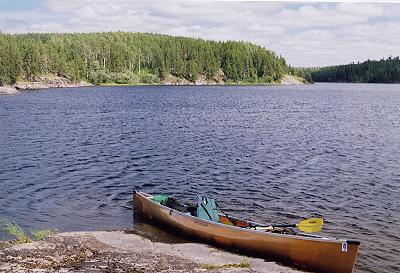Top to Bottom
|
| Go
to Part: 1 2 3 |
More Canoe Stories |
Day Thirteen- My to Craven
At first light I was up and packing the canoe. I found the best way out of the lake was to go to the big beaver dam on the creek 362840 5681233 and carry my loads through the trees about 100 meters and then push through some alders and walk along the west side of the marsh for another 300 meters. At that point it was solid enough to walk out to the stream channel and load the canoe for the pull to better water. The Solitary Sandpipers were still on the mudflat but the Lesser Yellowlegs must have continued its early migration. The sky is overcast for the first time in a week and the mosquitoes are taking advantage of it. When I got to the 175 meter portage there is no one around but it looks to be heavily used. There is enough bear bait lying around that I go back quickly and get a few pictures of the rapids before getting back to my food pack.
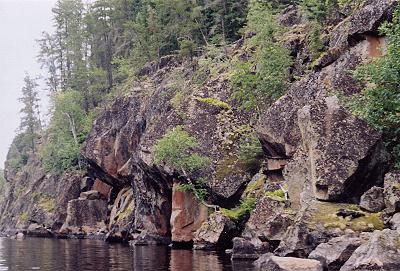 As soon as I leave the rapids I realize that the beauty I love most has returned to the landscape. The river has narrowed and the walls have risen. Soon I am gazing at the pictographs and drifting by fractured and broken walls of rock. There are birds in the air; an eagle and an osprey play a game of chicken as they pass. A Merlin flies toward and island and the Gray Jays sound an alarm. The Merlin alights on the very top of a tree and a Gray Jay, knowing this predator relies on speed for the catch, lands on the nearest treetop. I stop at a nice campspot 351975 5685618 on an outcrop with tent pads in the trees. A stream enters at the site and it looks like good moose country upstream. After a lunch of Mac and Cheese to fortify me for the 2200 and 1300 meter portages ahead I paddle on through the dead calm waters. The air is cool and that will be a bonus during the long portages.
As soon as I leave the rapids I realize that the beauty I love most has returned to the landscape. The river has narrowed and the walls have risen. Soon I am gazing at the pictographs and drifting by fractured and broken walls of rock. There are birds in the air; an eagle and an osprey play a game of chicken as they pass. A Merlin flies toward and island and the Gray Jays sound an alarm. The Merlin alights on the very top of a tree and a Gray Jay, knowing this predator relies on speed for the catch, lands on the nearest treetop. I stop at a nice campspot 351975 5685618 on an outcrop with tent pads in the trees. A stream enters at the site and it looks like good moose country upstream. After a lunch of Mac and Cheese to fortify me for the 2200 and 1300 meter portages ahead I paddle on through the dead calm waters. The air is cool and that will be a bonus during the long portages.
The 2200 meter portage is a tough one. Coming from the north you keep climbing to high rock and then plunging down to bog again. This happens a number of times and the pitches are very steep in places. Like, why is the front of my canoe hitting the ground? Yes, that steep in some places! At one point I was climbing higher and higher with the canoe on my shoulders and could not spot the next cairn. I looked around and was sad to see the portage dropped down from there to the bog again and it went down very steeply. The south quarter is flatter and goes through a bog. I would not want to try this portage when the rocks were wet. Using the leapfrog method I completed the portage in two hours. It was a self test for me. I quit running a year ago to preserve the cartilage in my knees and hips for more fun things like canoe trips. Biking and step machines have been my conditioning since so I was happy to see that I could still huff and puff for a few hours and not tire.
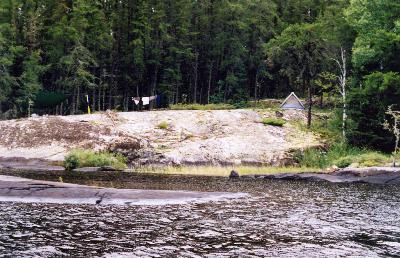 After a short rest and eating some more carbs, no place for the Adkins diet out here if you want the power to do these portages, I headed for the wet 1300 meter portage. My initial five minute carry was on dry ground. When I leapfrogged past with my second carry I entered the wet and very soft. The mosquitoes have gotten pretty bad so I push on hard. Knowing it was the last portage of the day I pushed on as for as I could, each step being one less the next time I carried this load. The portage is wet all the way to the end and the mosquitoes follow my canoe out into open water. It is getting late but I paddle on searching for a breezy point on Craven to camp on. A spot on the western shore 349528 5676429 works. It is not on a point but is in the breeze. It is after seven and I know the bugs will force me into the tent before nine so I hustle setting up camp. An hour later I have managed to take a swim, set up tent and tarp, have supper and dessert ready to eat and have the laundry soaking in my pail. My day ends perfectly with a Spruce Grouse flushing from a tree near shore and flying by while I finish dessert.
After a short rest and eating some more carbs, no place for the Adkins diet out here if you want the power to do these portages, I headed for the wet 1300 meter portage. My initial five minute carry was on dry ground. When I leapfrogged past with my second carry I entered the wet and very soft. The mosquitoes have gotten pretty bad so I push on hard. Knowing it was the last portage of the day I pushed on as for as I could, each step being one less the next time I carried this load. The portage is wet all the way to the end and the mosquitoes follow my canoe out into open water. It is getting late but I paddle on searching for a breezy point on Craven to camp on. A spot on the western shore 349528 5676429 works. It is not on a point but is in the breeze. It is after seven and I know the bugs will force me into the tent before nine so I hustle setting up camp. An hour later I have managed to take a swim, set up tent and tarp, have supper and dessert ready to eat and have the laundry soaking in my pail. My day ends perfectly with a Spruce Grouse flushing from a tree near shore and flying by while I finish dessert.
Day Fourteen-Rain Day on Craven
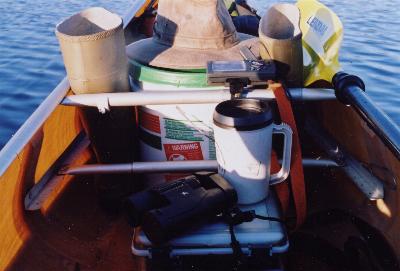 A stiff NE wind starts to blow during the night and by the time I awake it is a drizzly cold 55 degrees F, 14 C. The wind is blowing sheets of light rain across the lake but my camp is well protected. Up until this I have been blessed with exceptional weather that has put me a day ahead on the loose schedule that I am following. Being one day ahead means that I have avoided slippery rocks on the 2200 meter portage. The cold, wind, and rain have persuaded me to alter my plans of touring Carroll Lake and remain on Craven another day. The drizzle comes and goes as I watch the misty clouds of it race across the lake. While relaxing I start to assess the trip. I am always tweaking my method of doing these trips. By far the best tweak this year has been the Garmin Topo maps on CD allowing me to upload them into my GPSís. In this era of full financial disclosure I must say that I own shares of Garmin (GRMN.) It has opened up an easy way to explore the seldom seen places. It has also allowed me to enjoy the country so much more. Traveling with a map through new country requires that you constantly keep track of your position on the map. If you donít it is hard to figure out where you are amongst the islands and bays. With the map installed in my GPS I can head in the general direction and then when I approach a turn or a portage check my position on the screen. Before I left home I recorded all the portages from the park map in my GPSís memory. To save batteries the GPS is only turned on for a minute or two in these needed places. It is so nice to travel around freely and enjoy the beauty. We are all familiar with the sight of a canoe stalled in the water with at least one occupant hunched over and staring for long minutes at the map. If you load your GPS with your route segments (the GPS has a limit on the number of waypoints in a route but accepts many routes) you can follow the line and never get off track at all. If you do this bring more batteries than you think you will need.
A stiff NE wind starts to blow during the night and by the time I awake it is a drizzly cold 55 degrees F, 14 C. The wind is blowing sheets of light rain across the lake but my camp is well protected. Up until this I have been blessed with exceptional weather that has put me a day ahead on the loose schedule that I am following. Being one day ahead means that I have avoided slippery rocks on the 2200 meter portage. The cold, wind, and rain have persuaded me to alter my plans of touring Carroll Lake and remain on Craven another day. The drizzle comes and goes as I watch the misty clouds of it race across the lake. While relaxing I start to assess the trip. I am always tweaking my method of doing these trips. By far the best tweak this year has been the Garmin Topo maps on CD allowing me to upload them into my GPSís. In this era of full financial disclosure I must say that I own shares of Garmin (GRMN.) It has opened up an easy way to explore the seldom seen places. It has also allowed me to enjoy the country so much more. Traveling with a map through new country requires that you constantly keep track of your position on the map. If you donít it is hard to figure out where you are amongst the islands and bays. With the map installed in my GPS I can head in the general direction and then when I approach a turn or a portage check my position on the screen. Before I left home I recorded all the portages from the park map in my GPSís memory. To save batteries the GPS is only turned on for a minute or two in these needed places. It is so nice to travel around freely and enjoy the beauty. We are all familiar with the sight of a canoe stalled in the water with at least one occupant hunched over and staring for long minutes at the map. If you load your GPS with your route segments (the GPS has a limit on the number of waypoints in a route but accepts many routes) you can follow the line and never get off track at all. If you do this bring more batteries than you think you will need.
Another addition was a Lexon case for my camera gear. It came from Gander Mountain and has a neoprene seal. It is large enough to hold my SLR with a zoom lens attached and a few others lens. Fit in there also is a polarizing filter to make the clouds stand out. It is tethered at my feet so whether it is bears or snapping turtles I am on them in an instant no matter what the weather. With all that gear it still floats too. I have always used a kayak paddle but this year I am using one from Lendal. An allen key is used to tighten it after you put it together. It makes it a light and stiff paddle. To keep water from running down the shaft and into my lap I put it together so there is no offset in the blades. This allows the blade to act a drip point and the water falls from the bottom of the blade. It is important also to keep the paddle low and do not dig deep like you do with a regular paddle. The top of the blade should be at the waters surface. All of this keeps my canoe dry unless there is a fierce crosswind bringing the drips into the canoe. My backup paddle this year is a regular paddle with a thick and tough plastic blade. I use it for pushing off the rocks in the creeks but its main use is as walking stick when I am carrying my canoe and a pack. It makes the precarious portages so much easier I do not know why it took me so long to do it.
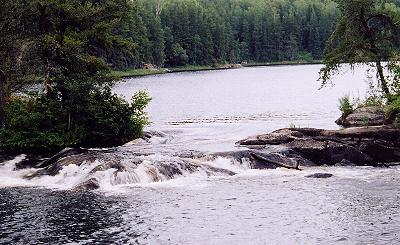 A high back Crazy Creek chair is lashed to the seat in my 17 foot Wenonah Prism made from Kevlar and weighing only 37 pounds. My food this year is pretty simple. A blend of Red River and Wheatena cereal for breakfast. It cooks with no tending as I break camp in the morning. Lunches are all Mac and Cheese with some Lipton Cajun Bean and Rice for variety. Suppers are a mixture of Lipton rice and pasta meals fortified with foil packets of chicken and tuna from Tyson and Sunkist. If I am really hungry after a long day I fix a Chicken Helper with the Tyson Chicken added. Desserts, used mostly for the calories, are instant puddings prepared with dry milk. On past trips I have used the double freeze dried meals but did not get enough calories to sustain me. My fish frys have been filled out with Betty Crocker Hash Browns. I skip the butter that these hash browns and the Mac and Cheese call for. A small portion of trail mix fills out my menu. All of this food and equipment weighed in at 175 pounds at the start of the trip. These long portages were left until last on purpose. My last and most precious piece of equipment is my plastic bucket. It is my seat and portable kitchen. Everything I use is in the bucket. I stock it in the morning with the dayís lunch so when I pull over it is the only thing that has to be removed from the canoe. Yesterday it served as a pontoon when I stumbled on the creek from My Lake. Unconventional I know but used for many things on my trips.
A high back Crazy Creek chair is lashed to the seat in my 17 foot Wenonah Prism made from Kevlar and weighing only 37 pounds. My food this year is pretty simple. A blend of Red River and Wheatena cereal for breakfast. It cooks with no tending as I break camp in the morning. Lunches are all Mac and Cheese with some Lipton Cajun Bean and Rice for variety. Suppers are a mixture of Lipton rice and pasta meals fortified with foil packets of chicken and tuna from Tyson and Sunkist. If I am really hungry after a long day I fix a Chicken Helper with the Tyson Chicken added. Desserts, used mostly for the calories, are instant puddings prepared with dry milk. On past trips I have used the double freeze dried meals but did not get enough calories to sustain me. My fish frys have been filled out with Betty Crocker Hash Browns. I skip the butter that these hash browns and the Mac and Cheese call for. A small portion of trail mix fills out my menu. All of this food and equipment weighed in at 175 pounds at the start of the trip. These long portages were left until last on purpose. My last and most precious piece of equipment is my plastic bucket. It is my seat and portable kitchen. Everything I use is in the bucket. I stock it in the morning with the dayís lunch so when I pull over it is the only thing that has to be removed from the canoe. Yesterday it served as a pontoon when I stumbled on the creek from My Lake. Unconventional I know but used for many things on my trips.
The rain stopped during the morning so I spent the day walking the woods, catching Walleye on my pink Dardevle and exploring the creek on the east side of Craven. It has gotten even colder and the lure of a warm sleeping bag draws me to retire at seven. I rolled over a few times during the night and the wind had stopped but the drizzle returned.
Day Fifteen- Craven to Obukowin
With a very deep and long nights sleep I am on my way to the Carroll portage at six thirty. A Great Blue Heron greets me there and as I enter Carroll Lake some Mallards take wing. To my right there are twenty young mergansers seeing how fast they can cross the bay without leaving the water. Wings and feet thrash the water as they head for the finish line. With yet another great tailwind I reach the triangle sign marking the Obukowin to Siderock portage route in six hours from my camp on Craven. Check the index for the canoestories.com to find my story and maps describing the three portages in great detail. I fixed lunch on a rock island across from the sign and decide to cross the first portage and camp there while I start my field research on the mystifying portages. I followed the portage until there was a split in the trail. Most of the use was going left so I did too. I ended up at the camp that Jim Hegyi had listed in his trip journal. It was also the rock outcrop that Jim Dickieson had instructed me to look for. Jim Dickieson is a trapper that maintains the snowmobile portions of this trail system. I am deeply indebted to him for the details that he took the time to send me about the different ways to traverse these portages. All canoeists are indebted to him for the work he does maintaining these long trails on the Manitoba side of the line where no portage crews clear the trees for us. I went back and using another feature of the GPS I recorded a track as I walked along with the GPS on and the tracking feature activated. It leaves a bread crumb trail of where I walk on the map screen. When I complete a portage I can then label and save the track to memory. I was checking out the alternate trail section and walked it out to its boggy start at the lake when three canoes came across what Jim calls Kidney Lake. They wanted to know if this was the portage and I told them yes but take a better one at the rock outcrop. They were on their second day of portaging from Siderock Lake and had spent all day coming across the middle portage. I would find out later that it is only an eighteen minute walk and mostly on high ground if you know where to go on that middle portage. I was reading through the message that Jim had sent me about the third portage and realized there was yet another way to portage from Kidney to Obukowin. He called it the native portage and said it went on the ridge. I walked up the trail he had cut to connect to the snowmobile trail from the rock outcrop and spotted the native trail to the right. I followed it to Obukowin Lake and saved a track of it in my GPS. If it were not for Jim Dickieson sharing his knowledge I would not have found the other option. It also helped me to put together the puzzle of all the scattered bits of information I had found while researching. Later in the evening I went over and walked the middle portage with an eye out for a trail split that would put me up on the ridge and not on Jimís winter trail through some very wet areas. Eight minutes up the trail I saw what looked like a moose path overgrown with alder veering to the right and towards the ridge. I followed it and spotted some old ribbons and soon walked up on the "Stoneman" cairn that marks the canoe portage trail as it climbs from what Jim calls First Lake. I was ecstatic at having found the portage to be so easy. I dropped down to the floating bog on the edge of First Lake and could see that most canoeists were spotting the orange marker for Jimís snowmobile trail and slogging through it. Not only is it very wet but it is 350 meters longer than going up on the ridge via "Stoneman". You used to be able to spot Stoneman and his dog from the lake but the trees have grown enough since the last fire that he is difficult to see. His dog rocky seems to have fallen prey to the fire ring wolves and his pieces may now reside in the black coals near the Stoneman.
Day Sixteen-Kidney to Siderock
With most of the mystery taken out of the portages I enjoy the trip through the middle portage which is known to be the worst one of the three. When I approach the last portage I see another fine use for a plastic bucket. There is one over a high stump that marks the portage. The conditions on this last mile and a half portage are about as good as they can get. Read some of the other accounts of canoeist traveling this portage and it will be hard to believe we are describing the same portage. Thanks to Jimís details I have a pleasant journey and arrive on Siderock for a late lunch. All I have left is a two hour paddle down the Wanipigow in the morning. I sit back after lunch and enjoy a cup of coffee and my last two Dove pieces.
Four geese come by very low to the water and are calling me back up the Wanipigow. You see as a child I would play Frankie Laineís The Cry of the Wild Goose over and over again on my parentís old 78 rpm record player. It is the tale of a man who is as much wandering goose as he is a man. It imprinted on me and now I am the goose in the song. Right now I need to get home and pack for another trip. The Jeep will be packed and my wife and I will embrace and pray and then with a kiss she will let me go because she knows it no use, she is married to the brother of the old wild goose.
| Go
to Part: 1 2 3 |
More Canoe Stories |
Copyright 2004 by Martin Kehoe- http://www.canoestories.com/kehoe/top_to_bottom1c.htm
